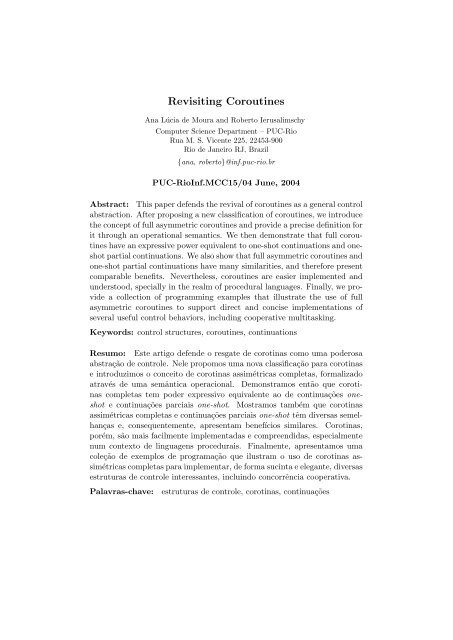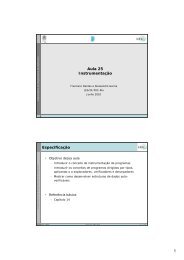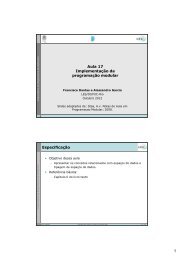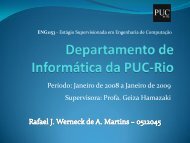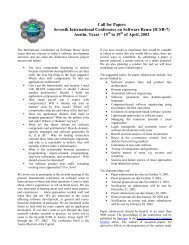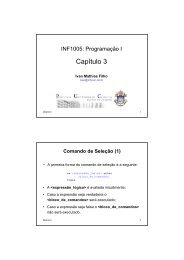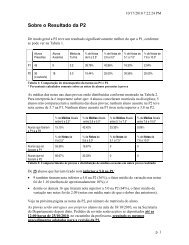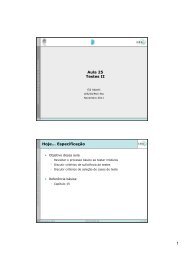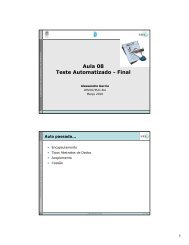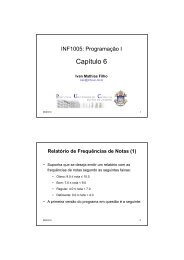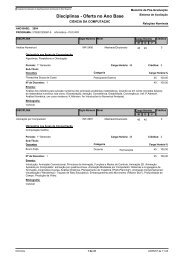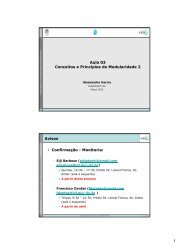Revisiting Coroutines - PUC-Rio
Revisiting Coroutines - PUC-Rio
Revisiting Coroutines - PUC-Rio
You also want an ePaper? Increase the reach of your titles
YUMPU automatically turns print PDFs into web optimized ePapers that Google loves.
<strong>Revisiting</strong> <strong>Coroutines</strong><br />
Ana Lúcia de Moura and Roberto Ierusalimschy<br />
Computer Science Department – <strong>PUC</strong>-<strong>Rio</strong><br />
Rua M. S. Vicente 225, 22453-900<br />
<strong>Rio</strong> de Janeiro RJ, Brazil<br />
{ana, roberto}@inf.puc-rio.br<br />
<strong>PUC</strong>-<strong>Rio</strong>Inf.MCC15/04 June, 2004<br />
Abstract: This paper defends the revival of coroutines as a general control<br />
abstraction. After proposing a new classification of coroutines, we introduce<br />
the concept of full asymmetric coroutines and provide a precise definition for<br />
it through an operational semantics. We then demonstrate that full coroutines<br />
have an expressive power equivalent to one-shot continuations and oneshot<br />
partial continuations. We also show that full asymmetric coroutines and<br />
one-shot partial continuations have many similarities, and therefore present<br />
comparable benefits. Nevertheless, coroutines are easier implemented and<br />
understood, specially in the realm of procedural languages. Finally, we provide<br />
a collection of programming examples that illustrate the use of full<br />
asymmetric coroutines to support direct and concise implementations of<br />
several useful control behaviors, including cooperative multitasking.<br />
Keywords: control structures, coroutines, continuations<br />
Resumo: Este artigo defende o resgate de corotinas como uma poderosa<br />
abstração de controle. Nele propomos uma nova classificação para corotinas<br />
e introduzimos o conceito de corotinas assimétricas completas, formalizado<br />
através de uma semântica operacional. Demonstramos então que corotinas<br />
completas tem poder expressivo equivalente ao de continuações oneshot<br />
e continuações parciais one-shot. Mostramos também que corotinas<br />
assimétricas completas e continuações parciais one-shot têm diversas semelhanças<br />
e, consequentemente, apresentam benefícios similares. Corotinas,<br />
porém, são mais facilmente implementadas e compreendidas, especialmente<br />
num contexto de linguagens procedurais. Finalmente, apresentamos uma<br />
coleção de exemplos de programação que ilustram o uso de corotinas assimétricas<br />
completas para implementar, de forma sucinta e elegante, diversas<br />
estruturas de controle interessantes, incluindo concorrência cooperativa.<br />
Palavras-chave:<br />
estruturas de controle, corotinas, continuações
1 Introduction<br />
The concept of coroutines was introduced in the early 1960s and constitutes<br />
one of the oldest proposals of a general control abstraction. It is<br />
attributed to Conway, who described coroutines as “subroutines who act as<br />
the master program”, and implemented this construct to simplify the cooperation<br />
between the lexical and syntactical analyzers in a COBOL compiler<br />
[Conway 1963]. The aptness of coroutines to express several useful<br />
control behaviors was widely explored during the next twenty years in several<br />
different contexts, including simulation, artificial intelligence, concurrent<br />
programming, text processing, and various kinds of data-structure manipulation<br />
[Knuth 1968; Marlin 1980; Pauli and Soffa 1980]. Nevertheless,<br />
designers of general-purpose languages have disregarded the convenience of<br />
providing a programmer with this powerful control construct, with rare exceptions<br />
such as Simula [Birtwistle et al. 1980], BCPL [Moody and Richards<br />
1980], Modula-2 [Wirth 1985], and Icon [Griswold and Griswold 1983].<br />
The absence of coroutine facilities in mainstream languages can be partly<br />
attributed to the lacking of an uniform view of this concept, which was<br />
never precisely defined. Marlin’s doctoral thesis [Marlin 1980], widely acknowledged<br />
as a reference for this mechanism, resumes the fundamental<br />
characteristics of a coroutine as follows:<br />
• “the values of data local to a coroutine persist between successive<br />
calls”;<br />
• “the execution of a coroutine is suspended as control leaves it, only to<br />
carry on where it left off when control re-enters the coroutine at some<br />
later stage”.<br />
This description of coroutines corresponds to the common perception of<br />
the concept, but leaves open relevant issues with respect to a coroutine<br />
construct. Apart from the capability of keeping state, we can identify three<br />
main issues that distinguish coroutine facilities:<br />
• the control-transfer mechanism, which can provide symmetric or asymmetric<br />
coroutines;<br />
• whether coroutines are provided in the language as first-class objects,<br />
which can be freely manipulated by the programmer, or as constrained<br />
constructs;<br />
• whether a coroutine is a stackful construct, i.e., whether it is able to<br />
suspend its execution from within nested calls.<br />
Depending on the intended use for the coroutine mechanism, particular<br />
solutions for the preceding issues were adopted. As a consequence, quite<br />
different implementations of coroutines were developed, such as Simula’s<br />
1
and Modula’s coroutine facilities, Icon’s generators and co-expressions, and,<br />
more recently, Python generators [Schemenauer et al. 2001]. Although all<br />
these constructs satisfy Marlin’s general characterization of coroutines, they<br />
provide significantly different degrees of expressiveness 1 .<br />
Besides the absence of a precise definition, the introduction of first-class<br />
continuations also greatly contributed to the virtual end of research interest<br />
in coroutines as a general control abstraction. Unlike coroutines, first-class<br />
continuations have a well-defined semantics and are widely acknowledged as<br />
an expressive construct that can be used to implement several interesting<br />
features, including generators, exception handling, backtracking [Felleisen<br />
1985; Haynes 1987], multitasking at the source level [Dybvig and Hieb 1989;<br />
Wand 1980], and also coroutines [Haynes et al. 1986]. However, with the exception<br />
of Scheme [Kelsey et al. 1998], some implementations of ML [Harper<br />
et al. 1991], and an alternative implementation of Python [Tismer 2000],<br />
first-class continuations are not usually provided in programming languages.<br />
A relevant obstacle to the incorporation of continuations in a language is<br />
the difficulty to provide an efficient implementation of this construct. This<br />
difficulty is mainly due to the need of supporting multiple invocations of a<br />
continuation, which usually involves copying a captured continuation before<br />
it is modified [Hieb et al. 1990]. The observation that in most contexts<br />
continuations are actually invoked only once motivated Bruggeman et al.<br />
[1996] to introduce one-shot continuations, which are limited to a single invocation<br />
and thus eliminate the copying overhead associated with multi-shot<br />
continuations. One-shot continuations can replace multi-shot continuations<br />
in practically all their useful applications. Specially in the implementation<br />
of multitasking, one-shot continuations can provide significant performance<br />
benefits when compared to multi-shot continuations [Bruggeman et al. 1996].<br />
Apart from efficiency issues, the concept of a continuation as a representation<br />
of the rest of a computation is difficult to manage and understand,<br />
specially in the context of procedural languages. The abortive nature of a<br />
continuation invocation complicates considerably the structure of programs;<br />
even experienced programmers may have difficulties to understand the control<br />
flow of continuation-intensive applications. The convenience of limiting<br />
the extent of continuations and localizing the effects of their control operators<br />
motivated the introduction of partial continuations [Felleisen 1988;<br />
Johnson and Duggan 1988] and the proposal of a series of constructs based<br />
on this concept [Queinnec 1993]. Unlike traditional continuations, partial<br />
continuations represent only a “continuation slice” [Queinnec 1993], or the<br />
continuation of a subcomputation [Hieb et al. 1994]. Partial continuations<br />
are not abortive; they are composed with the current continuation and thus<br />
behave like regular functions. Danvy and Filinski [1990], Queinnec and Serpette<br />
[1991], and Sitaram [1993] demonstrated that control constructs based<br />
1 In this paper we use the concept of expressiveness as defined by Felleisen [1990].<br />
2
on partial continuations can provide more concise and understandable implementations<br />
of the classical applications of continuations, such as generators,<br />
backtracking, and multitasking. In all these applications, the restriction<br />
imposed to one-shot continuations can be applied to partial continuations,<br />
allowing more efficient implementations of the constructs. Despite their<br />
advantages over traditional continuations, partial continuations are not provided<br />
in common implementations of programming languages, even in the<br />
realm of Scheme.<br />
Another significant reason for the absence of coroutines in modern languages<br />
is the current adoption of multithreading as a de facto standard for<br />
concurrent programming. In the last years several research efforts have been<br />
dedicated to alternative concurrency models that can support more efficient<br />
and less error-prone applications, such as event-driven programming and cooperative<br />
multitasking. Nevertheless, mainstream languages like Java and<br />
C# still provide threads as their primary concurrency construct.<br />
The purpose of this paper is to defend the revival of coroutines as a powerful<br />
control abstraction, which fits nicely in procedural languages and can<br />
be easily implemented and understood. We argue and demonstrate that,<br />
contrary to common belief, coroutines are not far less expressive than continuations.<br />
Instead, when provided as first-class objects and implemented<br />
as stackful constructs — that is, when a full coroutine mechanism is implemented<br />
— coroutines have equivalent power to that of one-shot continuations.<br />
Based on similar arguments as presented in the proposals of<br />
partial continuations mechanisms — easiness to manage and understand,<br />
and support for more structured applications — we specifically defend full<br />
asymmetric coroutines as a convenient construct for language extensibility.<br />
The remainder of this paper is organized as follows. Section 2 proposes a<br />
classification of coroutine mechanisms based on the three issues mentioned<br />
earlier, and discusses their influence on the usefulness of a coroutine facility.<br />
Section 3 provides a formal description of our concept of full asymmetric<br />
coroutines and illustrates it with an example of a general-purpose programming<br />
language that implements this mechanism. In section 4 we show that<br />
full asymmetric coroutines can provide not only symmetric coroutine facilities<br />
but also one-shot continuations and one-shot partial continuations.<br />
Section 5 contains a collection of programming examples that use full asymmetric<br />
coroutines to provide direct implementations of several useful control<br />
behaviors, including multitasking. Finally, section 6 summarizes the paper<br />
and presents our conclusions.<br />
2 A Classification of <strong>Coroutines</strong><br />
The capability of keeping state between successive calls constitutes the general<br />
and commonly adopted description of a coroutine construct. However,<br />
3
we observe that the various implementations of coroutine mechanisms differ<br />
widely with respect to their convenience and expressive power. In this section<br />
we identify and discuss the three issues that most notably distinguish<br />
coroutine mechanisms and influence their usefulness.<br />
2.1 Control Transfer Mechanism<br />
A well-known classification of coroutines concerns the control-transfer operations<br />
that are provided and distinguishes the concepts of symmetric<br />
and asymmetric coroutines. Symmetric coroutine facilities provide a single<br />
control-transfer operation that allows coroutines to explicitly pass control<br />
between themselves. Asymmetric coroutine mechanisms (more commonly<br />
denoted as semi-symmetric or semi coroutines [Dahl et al. 1972]) provide<br />
two control-transfer operations: one for invoking a coroutine and one for<br />
suspending it, the latter returning control to the coroutine invoker. While<br />
symmetric coroutines operate at the same hierarchical level, an asymmetric<br />
coroutine can be regarded as subordinate to its caller, the relationship between<br />
them being somewhat similar to that between a called and a calling<br />
routine.<br />
Coroutine mechanisms to support concurrent programming usually provide<br />
symmetric coroutines to represent independent units of execution, like<br />
in Modula-2. On the other hand, coroutine mechanisms intended for implementing<br />
constructs that produce sequences of values typically provide asymmetric<br />
coroutines. Examples of this type of construct are iterators [Liskov<br />
et al. 1977; Murer et al. 1996] and generators [Griswold and Griswold 1983;<br />
Schemenauer et al. 2001]. The general-purpose coroutine mechanisms implemented<br />
by Simula and BCPL provide both types of control transfer. In<br />
the absence of a formal definition of coroutines, Simula’s mechanism, a truly<br />
complex implementation of coroutines, was practically adopted as a reference<br />
for a general-purpose coroutine mechanism and greatly contributed<br />
to the common misconception that symmetric and asymmetric coroutines<br />
have no equivalent power. However, it is easy to demonstrate that we can<br />
express any of these constructs in terms of the other; therefore, a generalpurpose<br />
coroutine mechanism can provide either symmetric or asymmetric<br />
coroutines. Providing both constructs only complicates the semantics of the<br />
mechanism, with no increase in its expressive power.<br />
Although equivalent in terms of expressiveness, symmetric and asymmetric<br />
coroutines are not equivalent with respect to ease of use. Handling<br />
and understanding the control flow of a program that employs even a moderate<br />
number of symmetric coroutines may require a considerable effort from<br />
a programmer. On the other hand, asymmetric coroutines behave like routines,<br />
in the sense that control is always transfered back to their invokers.<br />
Since even novice programmers are familiar with the concept of a routine,<br />
control sequencing is simpler to manage and understand. Moreover, asym-<br />
4
metric coroutines allow the development of more structured programs.<br />
2.2 First-class versus constrained coroutines<br />
An issue that considerably influences the expressive power of a coroutine<br />
mechanism is whether coroutines are provided as first-class objects. In some<br />
implementations of coroutines, typically intended for particular uses, coroutine<br />
objects are constrained within a textual bound and cannot be directly<br />
manipulated by the programmer. An example of this restricted form of<br />
coroutine is the iterator abstraction, which was originally proposed and implemented<br />
by the designers of CLU to permit the traversal of data structures<br />
independently of their internal representation [Liskov et al. 1977]. Because<br />
a CLU iterator preserves state between successive calls, they described it<br />
as a coroutine; actually, an iterator fits Marlin’s general characterization of<br />
coroutines. However, CLU iterators are confined within a for loop that can<br />
invoke exactly one iterator. This restriction imposes a considerable limitation<br />
to the use of the construct; parallel traversals of two or more data collections,<br />
for instance, are not possible. Sather iterators [Murer et al. 1996], inspired<br />
by CLU iterators, are also confined to a single call point within a loop<br />
construct. The number of iterators invoked per loop is not restricted as in<br />
CLU, but if any iterator terminates, the loop terminates. Although traversing<br />
multiple collections in a single loop is possible, asynchronous traversals,<br />
as required for merging data collections, have no simple solution. Icon’s<br />
goal-directed evaluation of expressions [Griswold and Griswold 1983] is an<br />
interesting language paradigm where backtracking is supported by another<br />
constrained form of coroutines, named generators — expressions that may<br />
produce multiple values. Besides providing a collection of built-in generators,<br />
Icon also supports user-defined generators, implemented by procedures<br />
that suspend instead of returning. Despite not being limited to a specific<br />
construct, Icon generators are confined within an expression and can only<br />
be invoked by explicit iteration or goal-directed evaluation. Icon generators<br />
are easier to use than CLU and Sather iterators, but they are not powerful<br />
enough to provide for programmer-defined control structures. This facility is<br />
only provided when coroutines are implemented as first-class objects, which<br />
can be freely manipulated by the programmer and invoked at any place.<br />
First-class coroutines are provided, for instance, by Icon co-expressions and<br />
the coroutine facilities implemented by Simula, BCPL, and Modula-2.<br />
2.3 Stackfulness<br />
Stackful coroutine mechanisms allow coroutines to suspend their execution<br />
from within nested functions; the next time the coroutine is resumed, its execution<br />
continues from the exact point where it suspended. Stackful coroutine<br />
mechanisms are provided, for instance, by Simula, BCPL, Modula-2, Icon,<br />
5
and also by CLU and Sather’s iterators.<br />
A currently observed resurgence of coroutines is in the context of scripting<br />
languages, notably Python and Perl. In Python [Schemenauer et al.<br />
2001], a function that contains an yield statement is called a generator<br />
function. When called, this function returns an object that can be resumed<br />
at any point in a program, so it behaves as an asymmetric coroutine. Despite<br />
constituting a first-class object, a Python generator is not a stackful<br />
construct; it can only suspend its execution when its control stack is at the<br />
same level that it was at creation time. In other words, only the main body<br />
of a generator can suspend. A similar facility has been proposed for Perl<br />
6 [Conway 2000]: the addition of a new type of return command, also called<br />
yield, which preserves the execution state of the subroutine in which it is<br />
called.<br />
Python generators and similar non-stackful constructs permit the development<br />
of simple iterators or generators but complicate the structure<br />
of more elaborate implementations. As an example, if items are produced<br />
within recursive or auxiliary functions, it is necessary to create an hierarchy<br />
of auxiliary generators that yield in succession until the original invocation<br />
point is reached. This type of generator is also not powerful enough to<br />
implement user-level multitasking.<br />
2.4 Full coroutines<br />
Based on the preceding discussion, we can argue that, according to our classification,<br />
two issues determine the expressive power of a coroutine facility:<br />
whether coroutines are first-class objects and whether they are stackful constructs.<br />
In the absence of these facilities, a coroutine mechanism cannot<br />
support several useful control behaviors, notably multitasking, and, therefore,<br />
does not provide a general control abstraction. We then introduce the<br />
concept of a full coroutine as a first-class, stackful object, which, as we will<br />
demonstrate later, can provide the same expressiveness as obtained with<br />
one-shot continuations.<br />
Full coroutines can be either symmetric or asymmetric; the selection of<br />
a particular control-transfer mechanism does not influence their expressive<br />
power. However, asymmetric coroutines are more easily managed and can<br />
support more succinct implementations of user-defined constructs. Therefore,<br />
we believe that full asymmetric coroutines mechanisms provide a more<br />
convenient control abstraction than symmetric facilities.<br />
3 Full Asymmetric <strong>Coroutines</strong><br />
The purpose of this section is to provide a precise definition for our concept<br />
of full asymmetric coroutines. We begin by introducing the basic operators<br />
6
of this model of coroutines. We then formalize the semantics of these operators<br />
by developing an operational semantics for a simple language that<br />
incorporates them. Finally, we provide an example of a programming language<br />
that implements a full asymmetric coroutine mechanism that closely<br />
follows our proposed semantics. We will use this language in the programming<br />
examples later presented in this paper.<br />
3.1 Coroutine Operators<br />
Our model of full asymmetric coroutines has three basic operators: create,<br />
resume, and yield. The operator create creates a new coroutine. It receives<br />
a procedural argument, which corresponds to the coroutine main body, and<br />
returns a reference to the created coroutine. Creating a coroutine does<br />
not start its execution; a new coroutine begins in suspended state with its<br />
continuation point set to the first statement in its main body.<br />
The operator resume (re)activates a coroutine. It receives as its first<br />
argument a coroutine reference, returned from a previous create operation.<br />
Once resumed, a coroutine starts executing at its saved continuation point<br />
and runs until it suspends or its main function terminates. In either case,<br />
control is transfered back to the coroutine’s invocation point. When its main<br />
function terminates, the coroutine is said to be dead and cannot be further<br />
resumed.<br />
The operator yield suspends a coroutine execution. The coroutine’s continuation<br />
point is saved so that the next time the coroutine is resumed, its<br />
execution will continue from the exact point where it suspended.<br />
Our coroutine operators provide a convenient facility to allow a coroutine<br />
and its invoker to exchange data. The first time a coroutine is activated,<br />
a second argument given to the operator resume is passed as an argument<br />
to the coroutine main function. In subsequent reactivations of a coroutine,<br />
that second argument becomes the result value of the operator yield. On the<br />
other hand, when a coroutine suspends, the argument passed to the operator<br />
yield becomes the result value of the operator resume that activated the<br />
coroutine. When a coroutine terminates, the value returned by its main<br />
function becomes the result value of its last reactivation.<br />
3.2 Operational Semantics<br />
In order to formalize our concept of full asymmetric coroutines, we now develop<br />
an operational semantics for this mechanism. The many similarities<br />
between asymmetric coroutines and subcontinuations (which we will discuss<br />
in Section 4.3) allow us to base this semantics on the operational semantics<br />
of subcontinuations described by Hieb et al. [1994]. We start with the<br />
same core language, a call-by-value variant of the λ-calculus extended with<br />
assignments. In this core language, the set of expressions (denoted by e)<br />
7
includes constants (c), variables (x), function definitions, function calls, and<br />
assignments:<br />
e → c | x | λx.e | e e | x := e<br />
Expressions that denote values (v) are constants and functions:<br />
v → c | λx.e<br />
A store θ, mapping variables to values, is included in the definition of the<br />
core language to allow side-effects:<br />
θ : variables → values<br />
The evaluation of the core language is defined by a set of rewrite rules<br />
that are applied to expression–store pairs until a value is obtained. Evaluation<br />
contexts [Felleisen and Friedman 1986] are used to determine, at each<br />
step, the next subexpression to be evaluated. The evaluation contexts (C)<br />
defined for the core language are<br />
C → □ | C e | v C | x := C<br />
The preceding definition specifies a left-to-right evaluation of applications,<br />
because the argument can only be in an evaluation context when the<br />
term in the function position is a value. The rewrite rules for evaluating the<br />
core language are given next:<br />
〈C[x], θ〉 ⇒ 〈C[θ(x)], θ〉 (1)<br />
〈C[(λx.e)v], θ〉 ⇒ 〈C[e], θ[x ← v]〉, x ∉ dom(θ) (2)<br />
〈C[x := v], θ〉 ⇒ 〈C[v], θ[x ← v]〉, x ∈ dom(θ) (3)<br />
Rule 1 states that the evaluation of a variable results in its stored value in<br />
θ. Rule 2 describes the evaluation of applications; in this case, α-substitution<br />
is assumed in order to guarantee that a fresh variable x is inserted into the<br />
store. In rule 3, which describes the semantics of assignments, it is assumed<br />
that the variable already exists in the store (i.e., it was previously introduced<br />
by an abstraction).<br />
In order to incorporate asymmetric coroutines into the language, we<br />
extend the set of expressions with labels (l), labeled expressions (l : e), and<br />
the coroutine operators:<br />
e → c | x | λx.e | e e | x := e | l | l : e | create e | resume e e | yield e<br />
In our extended language, we use labels as references to coroutines, and<br />
labeled expressions to represent a currently active coroutine. As we will see<br />
later, labeling a coroutine context allows us to identify the coroutine being<br />
suspended when the operator yield is evaluated. Because labels are used to<br />
8
eference coroutines, we must include them in the set of expressions that<br />
denote values:<br />
v → c | λx.e | l<br />
We also extend the definition of the store, allowing mappings from labels to<br />
values:<br />
θ : (variables ∪ labels) → values<br />
The definition of evaluation contexts must include the new expressions.<br />
In this new definition we have specified a left-to-right evaluation for the<br />
operator resume, since only when its first argument (a coroutine reference)<br />
has been reduced to a label value its extra argument is examined:<br />
C → □ | C e | v C | x := C |<br />
create C | resume C e | resume l C | yield C | l : C<br />
We actually use two types of evaluation contexts: full contexts (denoted<br />
by C) and subcontexts (denoted by C ′ ). A subcontext is an evaluation<br />
context that does not contain labeled contexts (l : C). It corresponds to<br />
an innermost active coroutine (i.e., a coroutine wherein no nested coroutine<br />
occurs).<br />
The rewrite rules that describe the semantics of the coroutine operators<br />
are given next:<br />
〈C[create v], θ〉 ⇒ 〈C[l], θ[l ← v]〉, l ∉ dom(θ) (4)<br />
〈C[resume l v], θ〉 ⇒ 〈C[l : θ(l) v], θ[l ← ⊥]〉 (5)<br />
〈C 1 [l : C ′ 2[yield v]], θ〉 ⇒ 〈C 1 [v], θ[l ← λx.C ′ 2[x]]〉 (6)<br />
〈C[l : v], θ〉 ⇒ 〈C[v], θ〉 (7)<br />
Rule 4 describes the action of creating a coroutine. It creates a new label<br />
to represent the coroutine and extends the store with a mapping from this<br />
label to the coroutine main function.<br />
Rule 5 shows that the resume operation produces a labeled expression,<br />
which corresponds to a coroutine continuation obtained from the store. This<br />
continuation is invoked with the extra argument passed to resume. In order<br />
to prevent the coroutine to be reactivated, its label is mapped to an invalid<br />
value, represented by ⊥.<br />
Rule 6 describes the action of suspending a coroutine. The evaluation<br />
of the yield expression must occur within a labeled subcontext (C 2 ′ ) that resulted<br />
from the evaluation of the resume expression that invoked the coroutine.<br />
This restriction guarantees that a coroutine always returns control to<br />
its correspondent invocation point. The argument passed to yield becomes<br />
the result value obtained by resuming the coroutine. The continuation of<br />
the suspended coroutine is represented by a function whose body is created<br />
from the corresponding subcontext. This continuation is saved in the store,<br />
replacing the mapping for the coroutine’s label.<br />
9
The last rule defines the semantics of coroutine termination, and shows<br />
that the value returned by the coroutine main function becomes the result<br />
value obtained by the last activation of the coroutine. The mapping of the<br />
coroutine label to ⊥, established when the coroutine was resumed, prevents<br />
the reactivation of a dead coroutine.<br />
3.3 An example of a full asymmetric coroutine facility<br />
Lua [Ierusalimschy et al. 1996; Ierusalimschy 2003] is a scripting language<br />
widely used in the game industry, an application domain where cooperative<br />
multitasking is a typical control behavior. Since its version 5.0 Lua provides<br />
a coroutine facility that closely follows the semantics we have just described.<br />
3.3.1 An Overview of Lua<br />
Lua is a light-weight language that supports general procedural programming<br />
with data description facilities. It is dynamically typed, lexically<br />
scoped, and has automatic memory management.<br />
Lua supports eight basic value types: nil, boolean, number, string, userdata,<br />
thread, function, and table. The types nil, boolean, number, and string<br />
have usual meanings. The type userdata allows arbitrary C data to be<br />
stored in Lua variables. The type thread represents an independent thread<br />
of control and is used to implement coroutines.<br />
Functions in Lua are first-class values: they can be stored in variables,<br />
passed as arguments to other functions, and returned as results. Lua functions<br />
are always anonymous; the syntax<br />
function foo(x) ... end<br />
is merely a syntactical sugar for<br />
foo = function (x) ... end<br />
Tables in Lua are associative arrays and can be indexed with any value;<br />
they may be used to represent ordinary arrays, symbol tables, sets, records,<br />
etc. In order to support a convenient representation of records, Lua uses a<br />
field name as an index and provides a.name as syntactic sugar for a["name"].<br />
Lua tables are created by means of constructor expressions. The simplest<br />
constructor ({}), creates a new, empty table. Table constructors can also<br />
specify initial values for selected fields as in {x = 1, y = 2}.<br />
Variables in Lua can be either global or local. Global variables are not<br />
declared and are implicitly given an initial nil value. Local variables are<br />
lexically scoped and must be explicitly declared.<br />
Lua provides an almost conventional set of statements, similar to those<br />
in Pascal or C, including assignments, function calls, and traditional control<br />
structures (if, while, repeat and for). Lua also supports some not so<br />
conventional features such as multiple assignments and multiple results.<br />
10
3.3.2 Lua <strong>Coroutines</strong><br />
Lua coroutine facilities implement our concept of full asymmetric coroutines<br />
[Moura et al. 2004]. Following the semantics of this mechanism, three<br />
basic operations are provided: create, resume, and yield, Like in most Lua<br />
libraries, these functions are packed in a global table (table coroutine).<br />
Function coroutine.create allocates a separate Lua stack for the new<br />
coroutine. It receives as argument a Lua function that represents the main<br />
body of the coroutine and returns a coroutine reference (a value of type<br />
thread). Quite often, the argument to coroutine.create is an anonymous<br />
function, like this:<br />
co = coroutine.create(function() ... end)<br />
Like functions, Lua coroutines are first-class values; they can be stored<br />
in variables, passed as arguments, and returned as results. There is no<br />
explicit operation for deleting a Lua coroutine; like any other value in Lua,<br />
coroutines are discarded by garbage collection.<br />
Functions coroutine.resume and coroutine.yield closely follow the<br />
semantics of the operators resume and yield described before. However, because<br />
Lua functions can return multiple results, this facility is also provided<br />
by Lua coroutines. This means that function coroutine.resume can receive<br />
a variable number of extra arguments, which are all returned by the corresponding<br />
call to function coroutine.yield. Likewise, when a coroutine<br />
suspends, the corresponding call to function coroutine.resume returns all<br />
the arguments passed to coroutine.yield.<br />
Like coroutine.create, the auxiliary function coroutine.wrap creates<br />
a new coroutine, but instead of returning the coroutine itself, it returns a<br />
function that, when called, resumes the coroutine. Any arguments passed<br />
to that function go as extra arguments to resume. The function also returns<br />
all the values returned by coroutine.resume, except the first one<br />
(a boolean error code). Usually, function coroutine.wrap is simpler to<br />
use than coroutine.create; it provides exactly what is typically needed: a<br />
function to resume a coroutine. Therefore, in all the programming examples<br />
provided in this paper we will be using coroutine.wrap.<br />
As an illustration of Lua coroutines, let us consider a classical example:<br />
an iterator that traverses a binary tree in pre-order, shown in Figure 1.<br />
In this example, tree nodes are represented by Lua tables containing three<br />
fields: key, left, and right. Field key stores the node value (an integer);<br />
fields left and right contain references to the node’s respective children.<br />
Function preorder iterator receives as argument a binary tree’s root node<br />
and returns an iterator that successively produces the values stored in the<br />
tree. The possibility of yielding from inside nested calls allows a concise<br />
implementation of the tree iterator: the traversal of the tree is performed<br />
by an auxiliary recursive function (preorder) that yields the produced value<br />
11
function preorder(node)<br />
if node then<br />
preorder(node.left)<br />
coroutine.yield(node.key)<br />
preorder(node.right)<br />
end<br />
end<br />
-- create an iterator<br />
function preorder_iterator(tree)<br />
return coroutine.wrap(function()<br />
preorder(tree)<br />
return nil<br />
end)<br />
end<br />
Figure 1: A binary tree iterator implemented with Lua coroutines<br />
directly to the iterator’s caller. The end of a traversal is signalled by a nil<br />
value, returned by the iterator’s main function when it terminates.<br />
Figure 2 shows an example of use of the binary tree iterator: merging two<br />
binary trees. Function merge receives as arguments the two trees’ root nodes.<br />
It begins by creating iterators for the trees (it1 and it2) and collecting<br />
their smallest elements (v1 and v2). The while loop prints the smallest<br />
value and reinvokes the correspondent iterator for obtaining its next element,<br />
continuing until the elements in both trees are exhausted.<br />
function merge(t1, t2)<br />
local it1 = preorder_iterator(t1)<br />
local it2 = preorder_iterator(t2)<br />
local v1 = it1()<br />
local v2 = it2()<br />
while v1 or v2 do<br />
if v1 ~= nil and (v2 == nil or v1 < v2) then<br />
print(v1); v1 = it1()<br />
else<br />
print(v2); v2 = it2()<br />
end<br />
end<br />
end<br />
Figure 2: Merging two binary trees<br />
12
4 Expressing Alternative Control Structures<br />
It is a common belief that coroutines are far less expressive than first-class<br />
continuations (e.g., [Friedman et al. 1984]) and, also, that asymmetric coroutines<br />
are less powerful than symmetric coroutines. In this section we contradict<br />
these misconceptions by showing that a language that incorporates<br />
full asymmetric coroutines can easily provide not only symmetric coroutines<br />
but also one-shot continuations and one-shot partial continuations. Therefore,<br />
any sort of control structure implemented by these constructs can be<br />
provided by full asymmetric coroutines.<br />
4.1 Symmetric <strong>Coroutines</strong><br />
The basic characteristic of symmetric coroutine facilities is the provision<br />
of a single control-transfer operation that allows coroutines to pass control<br />
explicitly among themselves. Marlin [1980] and Pauli and Soffa [1980] argued<br />
that symmetric and asymmetric coroutines have no equivalent power and<br />
that general coroutine facilities should provide both constructs. However, it<br />
is easy to demonstrate that we can provide any of these mechanisms using<br />
the other; therefore, no expressive power is lost if only asymmetric coroutines<br />
are provided in a language.<br />
The implementation of symmetric coroutines on top of asymmetric facilities<br />
is straightforward. Symmetrical transfers of control between asymmetric<br />
coroutines can be easily simulated with pairs of yield–resume operations and<br />
an auxiliary dispatching loop that acts as an intermediary in the switch of<br />
control between the two coroutines. When a coroutine wishes to transfer<br />
control, it yields to the dispatching loop, which in turn resumes the coroutine<br />
that must be reactivated.<br />
The code shown in Figure 3 illustrates this mechanism by providing a<br />
Lua library (coro) that supports the creation of symmetric coroutines and<br />
their control-transfer discipline. In order to allow coroutines to also transfer<br />
control to the main program, table coro provides a field (main) to represent<br />
it, simulating a coroutine reference. Another auxiliary field (current) is<br />
used to store a reference to the currently active coroutine.<br />
When a coroutine, or the main program, wishes to transfer control, it<br />
calls function coro.transfer, passing the coroutine to be (re)activated; an<br />
extra argument provided to this function allows coroutines to exchange data.<br />
If the main program is currently active, the dispatching loop is executed; if<br />
not, function coroutine.yield is called to reactivate the dispatcher. When<br />
control is to be transfered to the main program, function coro.transfer<br />
returns.<br />
In our implementation, we followed Modula’s semantics of coroutine termination,<br />
which specifies that the termination of a coroutine without an<br />
explicit transfer of control constitutes a run-time error [Wirth 1985]. In or-<br />
13
coro = {}<br />
coro.main = function() end<br />
coro.current = coro.main<br />
-- function to create a new coroutine<br />
function coro.create(f)<br />
local co = function(val)<br />
f(val)<br />
error("coroutine ended")<br />
end<br />
return coroutine.wrap(co)<br />
end<br />
-- function to transfer control to a coroutine<br />
function coro.transfer(co, val)<br />
if coro.current == coro.main then<br />
return coroutine.yield(co, val)<br />
end<br />
-- dispatching loop<br />
while true do<br />
coro.current = co<br />
if co == coro.main then<br />
return val<br />
end<br />
co, val = co(val)<br />
end<br />
end<br />
Figure 3: Implementing symmetric coroutines facilities<br />
der to implement this semantics, function coro.create wraps the coroutine<br />
body in a function that issues an error to terminate the main program when<br />
the coroutine terminates.<br />
4.2 One-shot Continuations<br />
A continuation represents the rest of a computation from a given point<br />
in the computation. When they are provided as first-class objects, as in<br />
Scheme [Kelsey et al. 1998] and some implementations of ML [Harper et al.<br />
1991], continuations can be used to implement a wide variety of control<br />
structures and thus represent a powerful tool for language extensibility.<br />
In Scheme, the procedure call/cc causes the current continuation to be<br />
packaged as a first-class object. This captured continuation is then passed<br />
to the argument of call/cc, which must be a procedure of one argument.<br />
If this procedure returns without invoking the continuation, its returned<br />
14
value becomes the value of the application of call/cc. If, at any time,<br />
the captured continuation is invoked with a value, this value is immediately<br />
returned to the continuation of the original call/cc application.<br />
Although conventional first-class continuation mechanisms allow a continuation<br />
to be invoked multiple times, in virtually all their useful applications<br />
continuations are invoked only once. Motivated by this fact, Bruggeman<br />
et al. [1996] introduced the concept of one-shot continuations and the<br />
control operator call/1cc. One-shot continuations differ from multi-shot<br />
continuations in that it is an error to invoke a one-shot continuation more<br />
than once, either implicitly (by returning from the procedure passed to<br />
call/1cc) or explicitly (by invoking the continuation created by call/1cc).<br />
The implementation of one-shot continuations described by Bruggeman<br />
et al. [1996] reveals the many similarities between this mechanism and symmetric<br />
coroutines. In this implementation, the control stack is represented<br />
as a linked list of stack segments, which are structured as stacks of frames or<br />
activation records. When a one-shot continuation is captured, the current<br />
stack segment is “encapsulated” in the continuation and a fresh stack segment<br />
is allocated to replace the current stack segment. In terms of symmetric<br />
coroutines, this corresponds to creating a new coroutine and transferring<br />
control to it. When a one-shot continuation is invoked, the current stack<br />
segment is discarded and control is returned to the saved stack segment.<br />
This is exactly what happens if the new coroutine, at any time, transfers<br />
control back to its creator.<br />
The similarities between one-shot continuations and symmetric coroutines<br />
allow us to provide a concise implementation of call/1cc using the<br />
symmetric coroutine facility described in Section 4.1. This implementation<br />
is shown in Figure 4.<br />
4.3 One-shot Subcontinuations<br />
Despite their expressive power, traditional continuations, either multi-shot<br />
or one-shot, are difficult to use; except for some trivial examples, they complicate<br />
considerably the structure of programs [Felleisen 1988; Danvy and<br />
Filinski 1990; Queinnec and Serpette 1991]. Most of the complexity involved<br />
in the use of continuations arise from the fact that they represent the whole<br />
rest of a computation. The need to constrain the extent of continuations<br />
and localize the effects of control operators motivated the proposal of several<br />
control abstractions based on the concept of partial continuations [Queinnec<br />
1993]. The essence of these abstractions is that the invocation of a captured<br />
partial continuation does not abort the current continuation; instead, partial<br />
continuations can be composed like regular functions.<br />
Subcontinuations [Hieb et al. 1994] are an example of a partial continuation<br />
mechanism. A subcontinuation represents the rest of an independent<br />
partial computation (a subcomputation) from a given point in that subcom-<br />
15
function call1cc(f)<br />
-- save the continuation "creator"<br />
local ccoro = coro.current<br />
-- invoking the continuation transfers control<br />
-- back to its creator<br />
local cont = function(val)<br />
if ccoro == nil then<br />
error("one shot continuation called twice")<br />
end<br />
coro.transfer(ccoro, val)<br />
end<br />
-- when a continuation is captured,<br />
-- a new coroutine is created and dispatched<br />
local val<br />
val = coro.transfer(coro.create(function()<br />
local v = f(cont)<br />
cont(v)<br />
end))<br />
-- when control is transfered back, the continuation<br />
-- was "shot" and must be invalidated<br />
ccoro = nil<br />
-- the value passed to the continuation<br />
-- is the return value of call1/cc<br />
return val<br />
end<br />
Figure 4: Implementing one-shot continuations with symmetric coroutines<br />
putation. The operator spawn establishes the base, or root, of a subcomputation.<br />
It takes as argument a procedure (the subcomputation) to which<br />
it passes a controller. If the controller is not invoked, the result value of<br />
spawn is the value returned by the procedure. If the controller is invoked,<br />
it captures and aborts the continuation from the point of invocation back<br />
to, and including, the root of the subcomputation. The procedure passed<br />
to the controller is then applied to that captured subcontinuation. A controller<br />
is only valid when the corresponding root is in the continuation of the<br />
program. Therefore, once a controller has been applied, it will only be valid<br />
again if the subcontinuation is invoked, reinstating the subcomputation.<br />
Like one-shot continuations and symmetric coroutines, one-shot subcontinuations<br />
and full asymmetric coroutines have many similarities. Full asymmetric<br />
coroutines can be regarded as independent subcomputations. Invoking<br />
a subcomputation controller is similar to suspending an asymmetric<br />
16
coroutine. Invoking a one-shot subcontinuation corresponds to resuming an<br />
asymmetric coroutine. Like subcontinuations, asymmetric coroutines can<br />
be composed: they behave like regular functions, always returning control<br />
to their invoker. The main difference between subcontinuations and full<br />
asymmetric coroutines, and also between subcontinuations and other types<br />
of partial continuations, is that the reified subcontinuation is not restricted<br />
to the innermost subcomputation. Instead, a subcontinuation extends from<br />
the controller invocation point up to the root of the invoked controller, and<br />
may include several nested subcomputations.<br />
The similarities between one-shot subcontinuations and full asymmetric<br />
coroutines allow us to express one-shot subcontinuations in terms of Lua<br />
coroutines and provide the implementation of the operator spawn shown in<br />
Figure 5. When function spawn is invoked, a Lua coroutine (subc) is created<br />
to represent the subcomputation. This coroutine’s main body invokes<br />
spawn’s functional argument (f), passing to it a locally defined function that<br />
implements the subcomputation controller. Variable valid controller indicates<br />
if it is legal to invoke the controller; its value is true only when<br />
the correspondent coroutine is active. The controller function creates a subcontinuation<br />
by suspending the coroutine; variable shot indicates whether<br />
this subcontinuation was invoked (i.e., whether the coroutine was resumed).<br />
When the coroutine is resumed, function controller returns to its caller,<br />
reactivating the subcomputation from the controller invocation point. The<br />
argument passed to the subcontinuation (returned by coroutine.yield)<br />
becomes the result value of the controller invocation.<br />
Function subK is responsible for spawning and reinstating the subcomputation;<br />
it does so by resuming the correspondent coroutine. If the subcomputation<br />
ends without invoking the controller, the coroutine main body<br />
returns to its invocation point the result value obtained from calling f and<br />
a nil value (see line 6 in Figure 5). In this case, function subK terminates<br />
(line 28) and spawn returns to its caller the value returned by f. When the<br />
controller is invoked, the coroutine invocation (line 24) gets the argument<br />
passed to the controller (a function to be applied to the subcontinuation) and<br />
also a reference to the invoked controller. The controller reference, passed<br />
as the second argument to coroutine.yield (line 13), allows us to simulate<br />
a subcontinuation composed by an arbitrary number of nested subcomputations<br />
2 . When a coroutine suspends, the returned controller reference is<br />
checked to verify if it belongs to the current scope (line 32). If it does, the<br />
function passed to the controller is applied to the subcontinuation. If not,<br />
it means that the invoked controller corresponds to an outer subcomputation,<br />
so the current coroutine calls coroutine.yield to reactivate it (line<br />
2 This behavior is also provided by variants of some partial-continuation mechanisms<br />
that use marks [Queinnec and Serpette 1991] or tags [Sitaram 1993] to specify the context<br />
up to which a partial continuation is to be reified.<br />
17
1 function spawn(f)<br />
2 local controller, valid_controller, shot, subK<br />
3<br />
4 -- a coroutine represents a subcomputation<br />
5 local subc = coroutine.wrap(function()<br />
6 return f(controller), nil<br />
7 end)<br />
8<br />
9 -- this function implements the subcomputation controller<br />
10 function controller(fc)<br />
11 if not valid_controller then error("invalid controller") end<br />
12 shot = false<br />
13 val = coroutine.yield(fc, controller)<br />
14 shot = true<br />
15 return val<br />
16 end<br />
17<br />
18 -- this function spawns/reinstates a subcomputation<br />
19 function subK(v)<br />
20 if shot then error("subcontinuation called twice") end<br />
21<br />
22 -- invoke a subcontinuation<br />
23 valid_controller = true<br />
24 local ret, c = subc(v)<br />
25 valid_controller = false<br />
26<br />
27 -- subcomputation terminated ?<br />
28 if c == nil then return ret<br />
29<br />
30 -- if the local controller was invoked, apply<br />
31 -- the function to the subcontinuation<br />
32 elseif c == controller then return ret(subK)<br />
33<br />
34 -- the invoked controller corresponds to<br />
35 -- an outer subcomputation<br />
36 else<br />
37 val = coroutine.yield(ret, c)<br />
38 return subK(val)<br />
39 end<br />
40 end<br />
41<br />
42 -- spawn the subcomputation<br />
43 shot = false<br />
44 return subK()<br />
45 end<br />
Figure 5: Implementing spawn<br />
18
37). This process is repeated until the controller root is reached, allowing us<br />
to include all the suspended subcomputations in the captured subcontinuation.<br />
Symmetrically, invoking this subcontinuation will successively resume<br />
the suspended coroutines until the original controller invocation point is<br />
reached.<br />
4.4 Efficiency issues<br />
Haynes et al. [1986] demonstrated that continuations can be used to implement<br />
coroutines. Sitaram [1994] showed that coroutines can also be expressed<br />
in terms of partial continuations. We have just shown that full asymmetric<br />
coroutines can be used to express both one-shot continuations and<br />
one-shot partial continuations, which allow us to argue that full asymmetric<br />
coroutines have equivalent expressive power to those abstractions. However,<br />
expressing one-shot continuations and subcontinuations with coroutines and<br />
the reverse operations may not be equivalent in terms of efficiency.<br />
In a simple implementation of one-shot continuations as described by<br />
Bruggeman et al. [1996], the creation of a continuation involves the conversion<br />
of the current stack segment into a continuation object and the<br />
allocation a new stack segment to replace it. When a one-shot continuation<br />
is invoked, the current segment is discarded and control is returned to the<br />
saved stack segment. The creation of a coroutine also involves the allocation<br />
of a separate stack. The actions of suspending and resuming a coroutine are<br />
just a little more expensive than regular function calls.<br />
In our implementation of one-shot continuations, the creation of a single<br />
coroutine — i.e., a single stack “segment” — was sufficient to implement a<br />
continuation. Therefore, with a language that implements full coroutines we<br />
can provide one-shot continuation mechanisms that perform as efficiently as<br />
a simple direct implementation of this abstraction. On the other hand, the<br />
implementation of coroutines with continuations, as developed by Haynes<br />
et al. [1986], typically requires the capture of a new continuation each time a<br />
coroutine is suspended. This implementation thus involves the allocation of<br />
a new stack segment for each control transfer and, hence, performs much less<br />
efficiently and uses more memory than a direct implementation of coroutines.<br />
Hieb et al. [1994] described a possible implementation of subcontinuations<br />
that uses a stack of labeled stacks. To ensure efficiency, this stack is<br />
represented by a stack of label-address pairs, with each address pointing to<br />
a stack segment stored elsewhere. Invoking spawn results in the addition of<br />
a new empty stack to the stack of labeled stacks; to this new stack a label<br />
is assigned in order to associate it with its correspondent controller. When<br />
the controller is invoked, all the stacks down to the one with the associated<br />
label are removed from the stack of labeled stacks, and packaged into a<br />
subcontinuation. When the subcontinuation is invoked, its saved stacks are<br />
pushed onto the current stack of labeled stacks.<br />
19
In our implementation of one-shot subcontinuations, the cost of spawning<br />
a subcomputation (i.e., the creation and activation of a coroutine) is<br />
equivalent to that of the proposed implementation of spawn. When a subcontinuation<br />
involves a single subcomputation (the more usual case), the<br />
capture and invocation of a subcontinuation can perform at least as efficiently<br />
as the described direct implementation of subcontinuations. In the<br />
more complicated case, where a subcontinuation includes several nested subcomputations,<br />
the successive resumptions of the involved subcomputations<br />
impose some overhead, but with a cost no much higher than a succession of<br />
function calls. On the other hand, the implementation of coroutines with<br />
subcontinuations also requires the capture of a subcontinuation for each<br />
control transfer and, so, is arguably less efficient than a simple direct implementation<br />
of coroutines.<br />
Kumar et al. [1998] described an implementation of one-shot subcontinuations<br />
in terms of threads. Their basic idea is somewhat similar to ours:<br />
a subcomputation is represented by a child thread, which is created when<br />
spawn is invoked. The parent thread is then put to sleep, waiting on a done<br />
condition, which is associated to the subcomputation controller. When the<br />
controller is invoked, the child thread wakes up the root thread by signalling<br />
the correspondent done condition, and then suspends its execution<br />
by creating and waiting on a continue condition. When a subcontinuation<br />
is invoked, the correspondent thread is woken by signalling its continue<br />
condition, and the invoker is put to sleep waiting on the controller’s done<br />
condition. Besides the use of conditions to allow the suspension and resumption<br />
of threads (which, differently from coroutines, cannot explicitly<br />
transfer control), an additional synchronization mechanism (implemented<br />
with a mutex) is required to prevent a spawned child thread to signal the<br />
done condition before the parent thread is put to sleep 3 .<br />
The implementation of subcontinuations with threads does not involve<br />
the successive suspensions and resumptions of nested subcomputations that<br />
the use of coroutines requires. However, the use of threads introduces a<br />
considerable complexity and overhead, due to the need of synchronization<br />
mechanisms. Moreover, the capture of a subcontinuation requires the creation<br />
of a new condition, and the allocation of its associated structures.<br />
Besides being more efficient in the the more general case, implementing<br />
subcontinuations with coroutines is simpler and arguably less error-prone.<br />
3 This is actually a simplified description of the implementation shown in [Kumar et al.<br />
1998]. We have considered only the requirements for an implementation of non-concurrent<br />
subcontinuations.<br />
20
5 Programming With Full Asymmetric <strong>Coroutines</strong><br />
In the previous section we showed that a language with full asymmetric<br />
coroutines can easily provide one-shot continuations and one-shot partial<br />
continuations and, therefore, all control behaviors that can be implemented<br />
with those abstractions. In this section we complement our demonstration<br />
of the expressiveness of full asymmetric coroutines by providing succinct<br />
and elegant implementations of different control behaviors, including some<br />
representative examples of the use of continuations.<br />
5.1 The Producer–Consumer Problem<br />
The producer–consumer problem is the most paradigmatic example of the<br />
use of coroutines and constitutes a recurrent pattern in several scenarios.<br />
This problem involves the interaction of two independent computations:<br />
one that produces a sequence of items and one that consumes them, one at a<br />
time. Classical illustrations of this type of interaction use a pair of symmetric<br />
coroutines, with control being explicitly transfered back and forth between<br />
the producer and the consumer. However, asymmetric coroutines provide a<br />
simpler and more structured solution: we can implement the consumer as a<br />
conventional function that resumes the producer (an asymmetric coroutine)<br />
when the the next item is required 4 .<br />
A convenient extension of the producer–consumer structure is that of a<br />
pipeline, i.e., a producer–consumer chain consisting of an initial producer,<br />
one or more filters that perform some transformation on the transfered items,<br />
and a final consumer. Asymmetric coroutines provide a succinct implementation<br />
of pipelines too. A filter behaves both as a consumer and a producer,<br />
and can be implemented by a coroutine that resumes its antecessor to get a<br />
new value and yields the transformed value to its invoker (the next consumer<br />
in the chain). An implementation of a filter is shown in Figure 6. In a single<br />
statement we can create a pipeline by connecting the desired components<br />
and activating the final consumer:<br />
consumer(filter(producer()))<br />
5.2 Generators<br />
A generator is a control abstraction that produces a sequence of values, returning<br />
a new value to its caller for each invocation. Actually, generators are<br />
nothing more than a particular instance of the producer–consumer problem,<br />
with the generator behaving as the producer.<br />
4 This is an example of a consumer-driven design. When appropriate, a producer-driven<br />
solution can also be developed.<br />
21
function filter(ant)<br />
return coroutine.wrap(function()<br />
while true do<br />
-- resume antecessor to obtain value<br />
local x = ant()<br />
-- yield transformed value<br />
coroutine.yield(f(x))<br />
end<br />
end)<br />
end<br />
Figure 6: Implementing a filter with asymmetric coroutines<br />
A typical use of generators is to implement iterators, a related control<br />
abstraction that allows traversing a data structure independently of<br />
its internal implementation. Besides the capability of keeping state, the<br />
possibility of exchanging data when transferring control makes asymmetric<br />
coroutines a very convenient facility for implementing iterators. A classical<br />
example of an iterator implemented with Lua coroutines was shown in<br />
Section 3.3.2. However, the usefulness of generators is not restricted to implementing<br />
data-structure iterators. The next section provides an example<br />
of the use of generators in a quite different scenario.<br />
5.3 Goal-oriented programming<br />
Goal-oriented programming, as implemented in pattern-matching [Griswold<br />
and Griswold 1983] and also in Prolog-like queries [Clocksin and Mellish<br />
1981] involves solving a problem or goal that is either a primitive goal or<br />
a disjunction of alternative goals. These alternative goals may be, in turn,<br />
conjunctions of subgoals that must be satisfied in succession, each of them<br />
contributing a partial outcome to the final result. In pattern-matching problems,<br />
matching string literals are primitive goals, alternative patterns are<br />
disjunctions of goals, and sequences of patterns are conjunctions of subgoals.<br />
In Prolog, the unification process is an example of a primitive goal, a relation<br />
constitutes a disjunction, and rules are conjunctions. In this context,<br />
solving a problem typically requires the implementation of a backtracking<br />
mechanism that successively tries each alternative until an adequate result<br />
is found.<br />
Some implementations of Prolog-style backtracking in terms of continuations<br />
(e.g., [Haynes 1987]) use multi-shot success continuations to produce<br />
values, and are used as examples of scenarios where one-shot continuations<br />
cannot be used [Bruggeman et al. 1996]. However, this type of control behavior<br />
can be easily implemented with full asymmetric coroutines used as<br />
22
-- matching a string literal (primitive goal)<br />
function prim(str)<br />
return function(S, pos)<br />
local len = string.len(str)<br />
if string.sub(S, pos, pos+len-1) == str then<br />
coroutine.yield(pos+len)<br />
end<br />
end<br />
end<br />
-- alternative patterns (disjunction)<br />
function alt(patt1, patt2)<br />
return function(S, pos)<br />
patt1(S, pos)<br />
patt2(S, pos)<br />
end<br />
end<br />
-- sequence of sub-patterns (conjunction)<br />
function seq(patt1, patt2)<br />
return function(S, pos)<br />
local btpoint = coroutine.wrap(function()<br />
patt1(S, pos)<br />
end)<br />
for npos in btpoint do patt2(S, npos) end<br />
end<br />
end<br />
Figure 7: Goal-oriented programming: pattern matching<br />
generators 5 . Wrapping a goal in a coroutine allows a backtracker (a simple<br />
loop) to successively retry (resume) the goal until an adequate result is<br />
found. A primitive goal can be defined as a function that yields a result<br />
at each invocation. A disjunction can be implemented by a function that<br />
sequentially invokes its alternative goals. A conjunction of two subgoals<br />
can be defined as a function that iterates on the first subgoal, invoking the<br />
second one for each produced outcome.<br />
As an example, let us consider a pattern-matching problem. Our goal<br />
is to match a string S with a pattern patt, which can be expressed by<br />
combining subgoals that represent alternative matchings or sequences of<br />
sub-patterns. An example of such a pattern is<br />
("abc"|"de")."x"<br />
5 This style of backtracking can also be implemented with one-shot partial continuations,<br />
as shown by Sitaram [1993], or even with restricted forms of coroutines, such as<br />
Icon generators.<br />
23
The implementation of pattern matching is shown in Figure 7. Each<br />
pattern function receives the subject string and a starting position. For<br />
each successful matching, it yields the next position to be checked. When it<br />
cannot find more matchings, it returns nil. Our primitive goal corresponds<br />
to matching a substring of S with a string literal. Function prim implements<br />
this goal; it receives as argument a string value and returns a function that<br />
tries to match it with a substring of S starting at the given position. If<br />
the goal succeeds, the position in S that immediately follows the match is<br />
yielded. Function prim uses two auxiliary functions from Lua’s string library:<br />
string.len, which returns the length of a string, and string.sub,<br />
which returns a substring starting and ending at the given positions. Alternative<br />
patterns for a substring correspond to a disjunction of goals. They are<br />
implemented by function alt, which receives as arguments the two alternative<br />
goals and returns a function that tries to find a match in S by invoking<br />
these goals. If a successful match is found, the new position yielded by the<br />
invoked goal goes directly to the function’s caller.<br />
Matching a substring with a sequence of patterns corresponds to a conjunction<br />
of subgoals, which is implemented by function seq. The resulting<br />
pattern function creates an auxiliary coroutine (btpoint) to iterate on the<br />
first subgoal. Each successful match obtained by invoking this subgoal results<br />
in a new position in S where the second subgoal is to be satisfied. If a<br />
successful match for the second subgoal is found, the new position yielded<br />
by it goes directly to the function’s caller.<br />
Using the functions just described, the pattern ("abc"|"de")."x" can<br />
be defined as follows:<br />
patt = seq(alt(prim("abc"), prim("de")), prim("x"))<br />
Finally, function match verifies if string S matches this pattern:<br />
function match(S, patt)<br />
local len = string.len(S)<br />
local m = coroutine.wrap(function() patt(S, 1) end)<br />
for pos in m do<br />
if pos == len + 1 then<br />
return true<br />
end<br />
end<br />
return false<br />
end<br />
5.4 Cooperative Multitasking<br />
One of the most obvious uses of coroutines is to implement multitasking.<br />
However, due mainly to the wide adoption of multithreading in modern mainstream<br />
languages, this suitable use of coroutines is currently disregarded.<br />
24
-- list of "live" tasks<br />
tasks = {}<br />
-- create a task<br />
function create_task(f)<br />
local co = coroutine.wrap(function() f(); return "ended" end)<br />
table.insert(tasks, co)<br />
end<br />
-- task dispatcher<br />
function dispatcher()<br />
while true do<br />
local n = table.getn(tasks)<br />
if n == 0 then break end -- no more tasks to run<br />
for i = 1,n do<br />
local status = tasks[i]()<br />
if status = "ended" then<br />
table.remove(tasks, i)<br />
break<br />
end<br />
end<br />
end<br />
end<br />
Figure 8: Implementing Cooperative Multitasking<br />
A language with coroutines does not require additional concurrency constructs:<br />
just like a thread, a coroutine represents a unit of execution with<br />
its private, local data while sharing global data and other resources with<br />
other coroutines. But while the concept of a thread is typically associated<br />
with preemptive multitasking, coroutines provide an alternative concurrency<br />
model which is essentially cooperative: a coroutine must explicitly request<br />
to be suspended to allow another coroutine to run.<br />
Preemptive scheduling and the consequent need for complex synchronization<br />
mechanisms make developing a correct multithreading application<br />
a difficult task. In some contexts, such as operating systems and real-time<br />
applications, timely responses are essential, and, therefore, preemption is<br />
unavoidable. However, the timing requirements for most concurrent applications<br />
are not critical. Moreover, most thread implementations do not<br />
provide any real timing guarantees. Application developers, also, have usually<br />
little or no experience in concurrent programming. In this scenario, a<br />
cooperative multitasking environment, which eliminates conflicts due to race<br />
conditions and minimizes the need for synchronization, seems much more<br />
appropriate.<br />
The implementation of cooperative multitasking in terms of full asym-<br />
25
metric coroutines is straightforward, as illustrated in Figure 8. Concurrent<br />
tasks are modeled by coroutines; when a new task is created, it is inserted<br />
in a list of live tasks. A simple task dispatcher is implemented by a loop<br />
that iterates on this list, resuming the live tasks and removing the ones that<br />
have finished their work (this condition is signalled by a predefined value<br />
returned by the coroutine main function). Occasional fairness problems,<br />
which are easy to identify, can be solved by adding suspension requests in<br />
time-consuming tasks.<br />
The only drawback of cooperative multitasking arises when using blocking<br />
operations; if, for instance, a coroutine calls an I/O operation and blocks,<br />
the entire program blocks until the operation completes. For many concurrent<br />
applications, this is an unacceptable behavior. However, this situation<br />
is easily avoided by providing auxiliary functions that initiate an I/O operation<br />
and suspend the active coroutine when the operation cannot be immediately<br />
completed. Ierusalimschy [2003] shows an example of a concurrent<br />
application that uses Lua coroutines and includes non-blocking facilities.<br />
Currently, there is some renewal of interest in cooperative multitasking<br />
as an alternative to multithreading [Adya et al. 2002; Behren et al. 2003].<br />
However, the concurrent constructs that support cooperative multitasking<br />
in the proposed environments are usually provided by libraries or system<br />
resources like Window’s fibers [Richter 1997]. Interestingly, although the<br />
description of the concurrency mechanisms employed in these environments<br />
is no more than a description of coroutines plus a dispatcher, the term<br />
coroutine is not even mentioned.<br />
5.5 Exception Handling<br />
A language that provides an exception handling mechanism typically implements<br />
two basic primitives: try and raise [Friedman et al. 2001]. The<br />
try primitive gets two expressions: a body and and an exception handler.<br />
When the body returns normally, its returned value becomes the value of<br />
try, and the exception handler is ignored. If the body encounters an exceptional<br />
condition, it raises an exception that is immediately sent to the<br />
handler; in this case, any unevaluated portion of the body is ignored. An<br />
exception handler can either return a value, which becomes the value of the<br />
associated try, or it can raise another exception, which is sent to the next<br />
dynamically enclosing handler.<br />
A language with full asymmetric coroutines can easily support exception<br />
handling. A try primitive can be implemented as a function that gets two<br />
function values (body and handler) and executes body in a coroutine. A<br />
raise primitive is merely a function that yields an exception.<br />
26
-- save original version of coroutine.wrap<br />
local wrap = coroutine.wrap<br />
-- redefine coroutine.wrap<br />
function coroutine.wrap(tag, f)<br />
-- create a "tagged" coroutine<br />
local co = wrap(function(v) return tag, f(v) end)<br />
return function(v)<br />
local rtag, ret = co(v) -- resume coroutine<br />
while (rtag ~= tag) do<br />
-- reactivate outer coroutine if tags do not match<br />
v = coroutine.yield(rtag, ret)<br />
-- reinstate inner coroutine<br />
tag, ret = co(v)<br />
end<br />
end<br />
-- tags match<br />
return ret<br />
end<br />
Figure 9: Avoiding Interference Between Control Actions<br />
5.6 Avoiding Interference Between Control Actions<br />
When asymmetric coroutines implement different control structures in a<br />
single program and these structures are nested, it may be necessary to avoid<br />
interferences between control actions. An undesirable interference may arise,<br />
for instance, when an iterator is used within a try structure and it raises<br />
an exception.<br />
We can avoid simple interferences if we identify pairs of control operations<br />
by associating each control structure with a different tag (a string,<br />
for instance) and implement a new version of function wrap that supports<br />
tags, as shown in Figure 9. In addition, function coroutine.yield takes a<br />
required first argument (a tag) in order to allow us to match yield–resume<br />
pairs. Notice that the basic idea of this solution is similar to that used for<br />
matching a subcomputation with its correspondent controller in our implementation<br />
of subcontinuations (see Section 4.3).<br />
While avoiding simple interferences is trivial either with coroutines or<br />
continuations, in the presence of concurrency interferences between control<br />
actions, and error handling in general, can be hard to tackle [Gasbichler<br />
et al. 2003]. However, due to the compositional nature of asymmetric coroutines,<br />
handling errors does not present difficulties when concurrency is also<br />
27
implemented with asymmetric coroutines.<br />
6 Conclusions<br />
After a period of intense investment, from the middle 1960s to the early<br />
1980s, the research interest in coroutines as a general control abstraction<br />
virtually stopped. Besides the absence of a precise definition of the concept,<br />
which led to considerably different implementations of coroutine facilities,<br />
the other factors that greatly contributed to the discard of this interesting<br />
construct were the introduction of first-class continuations (and the general<br />
belief that they were far more expressive than coroutines), and the adoption<br />
of threads as a “standard” concurrent construct.<br />
We now observe a renewal of interest in coroutines, notably in two different<br />
scenarios. The first corresponds to research efforts that explore the advantages<br />
of cooperative task management as an alternative to multithreading.<br />
In this scenario, some forms of coroutines are provided by libraries,<br />
or system resources, and are solely used as concurrent constructs. Another<br />
resurgence of coroutines is in the context of scripting languages, such as<br />
Python and Perl. In this case, restricted forms of coroutines support the<br />
implementation of simple iterators and generators, but are not powerful<br />
enough to constitute a general control abstraction; in particular, they cannot<br />
be used as a concurrent construct.<br />
In this paper we argued in favor of the revival of full asymmetric coroutines<br />
as a convenient general control construct, which can replace both oneshot<br />
continuations and multithreading with a single, and simpler, concept.<br />
In order to support this proposition, we provided the contributions described<br />
next.<br />
To fulfill the need of an adequate definition of the concept of a coroutine,<br />
we proposed a classification of coroutines based on three main issues:<br />
whether coroutines are symmetric or asymmetric, whether they are firstclass<br />
objects, and whether they are stackful constructs. We discussed the<br />
influence of each of these issues on the expressive power of a coroutine facility,<br />
and introduced the concept of full coroutines as first-class, stackful<br />
objects. We also discussed the advantages of full asymmetric coroutines<br />
versus full symmetric coroutines, which are equivalent in power, but not in<br />
ease of use.<br />
Next we provided a precise definition of a full asymmetric coroutine<br />
construct, supported by the development of an operational semantics for<br />
this mechanism. We then demonstrated that full asymmetric coroutines<br />
can provide not only symmetric coroutines but also one-shot continuations<br />
and one-shot partial continuations, and discussed the similarities between<br />
one-shot continuations and full symmetric coroutines, and between one-shot<br />
partial continuations and full asymmetric coroutines. We also showed that,<br />
28
although these constructs have equivalent power, they may not be equivalent<br />
in terms of efficiency.<br />
Finally, we provided a collection of programming examples that illustrate<br />
the use of full asymmetric coroutines to support concise and elegant<br />
implementations of several useful control behaviors, including some of the<br />
most relevant examples of the use of continuations.<br />
References<br />
Adya, A., Howell, J., Theimer, M., Bolosky, W. J., and Doucer, J. R. 2002.<br />
Cooperative Task Management without Manual Stack Management. In Proceedings<br />
of USENIX Annual Technical Conference. USENIX, Monterey, CA.<br />
Behren, R., Condit, J., and Brewer, E. 2003. Why Events are a Bad Idea (for highconcurrency<br />
servers). In Proceedings of the 9th Workshop on Hot Topics in Operating<br />
Systems (HotOS IX). Lihue, HI.<br />
Birtwistle, G., Dahl, O.-J., Myhrhaug, B., and Nygaard, K. 1980. Simula Begin.<br />
Studentlitteratur, Sweden.<br />
Bruggeman, C., Waddell, O., and Dybvig, R. 1996. Representing control in the<br />
presence of one-shot continuations. In Proceedings of the ACM SIGPLAN’96 Conf.<br />
on Programming Language Design and Implementation (PLDI). ACM, Philadelphia,<br />
PA, 99–107. SIGPLAN Notices 31(5).<br />
Clocksin, W. and Mellish, C. 1981. Programming in Prolog. Springer-Verlag.<br />
Conway, D. 2000. RFC 31: Subroutines: Co-routines.<br />
http://dev.perl.org/perl6/rfc/31.html.<br />
Conway, M. 1963. Design of a separable transition-diagram compiler. Communications<br />
of the ACM 6, 7 (July), 396–408.<br />
Dahl, O.-J., Dijkstra, E. W., and Hoare, C. A. R. 1972. Hierarchical program<br />
structures. In Structured Programming, Second ed. Academic Press, London, England.<br />
Danvy, O. and Filinski, A. 1990. Abstracting control. In Proceedings of the 1990<br />
ACM Conference on LISP and Functional Programming. ACM, Nice, France, 151–<br />
160.<br />
Dybvig, R. and Hieb, R. 1989. Engines from continuations. Computer Languages<br />
14, 2, 109–123.<br />
Felleisen, M. 1985. Transliterating Prolog into Scheme. Technical Report 182, Indiana<br />
University.<br />
Felleisen, M. 1988. The theory and practice of first-class prompts. In Proceedings<br />
of the 15th ACM Symposium on Principles of Programming Languages POPL’88.<br />
ACM, San Diego, CA, 180–190.<br />
Felleisen, M. 1990. On the expressive power of programming languages. In Proceedings<br />
of 3rd European Symposium on Programming ESOP’90. Copenhagen, Denmark, 134–<br />
151.<br />
Felleisen, M. and Friedman, D. 1986. Control operators, the secd-machine, and the<br />
λ-calculus. In Formal Description of Programming Concepts-III, M. Wirsing, Ed.<br />
North-Holland, 193–217.<br />
Friedman, D., Haynes, C., and Kohlbecker, E. 1984. Programming with continuations.<br />
In Program Transformation and Programming Environments, P. Pepper, Ed.<br />
Springer-Verlag.<br />
Friedman, D., Wand, M., and Haynes, C. 2001. Essentials of Programming Languages,<br />
Second ed. MIT Press, London, England.<br />
29
Gasbichler, M., Knauel, E., and Sperber, M. 2003. How to add threads to a<br />
sequential language without getting tangled up. In Proceedings of the 4th Workshop<br />
on Scheme and Functional Programming. Cambridge, MA, 30–47.<br />
Griswold, R. and Griswold, M. 1983. The Icon Programming Language. Prentice-<br />
Hall, New Jersey, NJ.<br />
Harper, R., Duba, B., Harper, R., and MacQueen, D. 1991. Typing first-class<br />
continuations in ML. In Proceedings of the 18th ACM Symposium on Principles of<br />
Programming Languages POPL‘91. ACM, Orlando, FL, 163–173.<br />
Haynes, C. T. 1987. Logic continuations. J. Logic Programming 4, 157–176.<br />
Haynes, C. T., Friedman, D., and Wand, M. 1986. Obtaining coroutines with continuations.<br />
Computer Languages 11, 3/4, 143–153.<br />
Hieb, R., Dybvig, R., and Anderson III, C. W. 1994. Subcontinuations. Lisp and<br />
Symbolic Computation 7, 1, 83–110.<br />
Hieb, R., Dybvig, R., and Bruggeman, C. 1990. Representing control in the presence<br />
of first-class continuations. In Proceedings of the ACM SIGPLAN’90 Conf. on<br />
Programming Language Design and Implementation (PLDI). ACM, White Plains,<br />
NY, 66–77. SIGPLAN Notices 25(6).<br />
Ierusalimschy, R. 2003. Programming in Lua. Lua.org, ISBN 85-903798-1-7, <strong>Rio</strong> de<br />
Janeiro, Brazil.<br />
Ierusalimschy, R., Figueiredo, L., and Celes, W. 1996. Lua — an extensible<br />
extension language. Software: Practice & Experience 26, 6 (June), 635–652.<br />
Johnson, G. and Duggan, D. 1988. Stores and partial continuations as first-class objects<br />
in a language and its environment. In Proceedings of the 15th ACM Symposium<br />
on Principles of Programming Languages POPL’88. ACM, San Diego, CA.<br />
Kelsey, R., Clinger, W., and Rees, J. 1998. Revised 5 report on the algorithmic<br />
language Scheme. ACM SIGPLAN Notices 33, 9 (Sept.), 26–76.<br />
Knuth, D. E. 1968. The Art of Computer Programming, Volume 1, Fundamental<br />
Algorithms. Addison-Wesley, Reading, MA.<br />
Kumar, S., Bruggeman, C., and Dybvig, R. 1998. Threads yield continuations. Lisp<br />
and Symbolic Computation 10, 3, 223–236.<br />
Liskov, B., Snyder, A., Atkinson, R., and Schaffert, C. 1977. Abstraction mechanisms<br />
in CLU. Communications of the ACM 20, 8 (Aug.), 564–576.<br />
Marlin, C. D. 1980. <strong>Coroutines</strong>: A Programming Methodology, a Language Design<br />
and an Implementation. LNCS 95, Springer-Verlag.<br />
Moody, K. and Richards, M. 1980. A coroutine mechanism for BCPL. Software:<br />
Practice & Experience 10, 10 (Oct.), 765–771.<br />
Moura, A., Rodriguez, N., and Ierusalimschy, R. 2004. <strong>Coroutines</strong> in lua. In 8th<br />
Brazilian Symposium of Progamming Languages (SBLP). SBC, Niteroi, RJ, Brazil.<br />
Murer, S., Omohundro, S., Stoutamire, D., and Szyperski, C. 1996. Iteration abstraction<br />
in Sather. ACM Transactions on Progamming Languages and Systems 18, 1<br />
(Jan.), 1–15.<br />
Pauli, W. and Soffa, M. L. 1980. Coroutine behaviour and implementation. Software:<br />
Practice & Experience 10, 3 (Mar.), 189–204.<br />
Queinnec, C. 1993. A library of highr-level control operators. ACM SIGPLAN Lisp<br />
Pointers 6, 4 (Oct.), 11–26.<br />
Queinnec, C. and Serpette, B. 1991. A dynamic extent control operator for partial<br />
continuations. In Proceedings of the 18th ACM Symposium on Principles of Programming<br />
Languages POPL‘91. ACM, Orlando, FL, 174–184.<br />
Richter, J. 1997. Advanced Windows, Third ed. Microsoft Press, Redmond, WA.<br />
Schemenauer, N., Peters, T., and Hetland, M. 2001. PEP 255 Simple Generators.<br />
http://www.python.org/peps/pep-0255.html.<br />
30
Sitaram, D. 1993. Handling control. In Proceedings of the ACM SIGPLAN’93 Conf.<br />
on Programming Language Design and Implementation (PLDI). ACM, Albuquerque,<br />
NM. SIGPLAN Notices 28(6).<br />
Sitaram, D. 1994. Models of control and their implications for progamming language<br />
design. Ph.D. thesis, Rice University.<br />
Tismer, C. 2000. Continuations and Stackless Python. In Proceedings of the 8th International<br />
Python Conference. Arlington, VA.<br />
Wand, M. 1980. Continuation-based multiprocessing. In Proceedings of the 1980 Lisp<br />
Conference. ACM, Stanford, CA, 19–28.<br />
Wirth, N. 1985. Programming in Modula-2 , Third, corrected ed. Springer-Verlag.<br />
31


